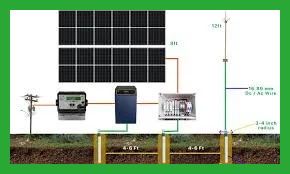
Solar earthing refers to the grounding system used in solar photovoltaic (PV) installations. It involves creating a safe pathway for electrical currents to flow to the ground in case of faults or lightning strikes. Proper earthing is crucial in solar installations to protect equipment, prevent electrical hazards, and ensure system reliability.
Key aspects of solar earthing include:
- Grounding Electrode System: This typically consists of grounding rods or plates buried in the earth near the solar array. These electrodes provide a low-resistance path to the ground.
- Bonding: Connecting all metal components of the solar PV system together and to the grounding electrode system. This includes solar panels, mounting structures, inverters, and metallic conduits.
- Compliance: Following local electrical codes and regulations which dictate specific requirements for earthing and grounding systems in solar installations.
- Testing and Maintenance: Periodically testing the earthing system to ensure it maintains low resistance and is capable of safely dissipating electrical faults.
Proper design and implementation of the solar earthing system are essential for the safety of both the equipment and personnel working on or around the solar PV system.